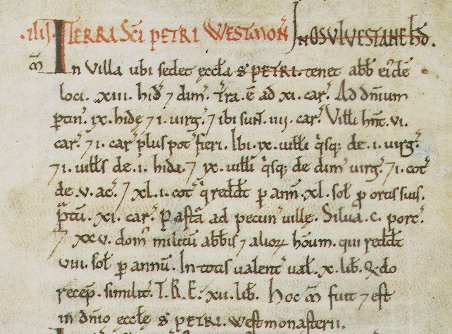Domesday Book


Here is subscribed the inquisition of lands as the barons of the king have made inquiry into them; that is to say by the oath of the sheriff of the shire, and of all the barons and their Frenchmen, and the whole hundred, the priests, reeves, and six villains of each manor; then, what the manor is called, who held it in the time of king Edward, who holds now; how many hides, how many plows in demesne, how many belonging to the men, how many villains, how many cottars, how many serfs, how many free-men, how many socmen, how much woods, how much meadow, how many pastures, how many mills, how many fish-ponds, how much has been added or taken away, how much it was worth altogether at that time, and how much now, how much each free man or soeman had or has. All this threefold, that i8 to say in the time of king Edward, and when king William gave it, and as it is now; and whether more can be had than is had.
In my search for more information on the Domesday Book, I found a web site definition courtesy of the UNB Archives.
I felt I was getting closer to Borley when the Funk & Wagnalls Knowledge Center web site told me, "The original manuscript was made in two volumes. The first and larger one, sometimes called the Great Domesday, included information on all England, with the exception of three eastern counties (Essex, Suffolk, and Norfolk), several northern counties, London, and some other towns. The surveys of the three eastern counties made up the second volume, which was known as the Little Domesday. These documents were frequently used in the medieval law courts, and in their published form they are occasionally used today in cases involving questions of topography or genealogy. The two volumes of the Domesday Book were first published in 1783; an index was published in a separate volume in 1811; and an additional volume, containing the Inquisitio Eliensis with surveys of the lands of Ely, was published in 1816."
There is a fascinating sentence in a web site for students. It says,
"...if we only used Domesday Book to find out about the Middle Ages we would think that there
were few women, and no children, monks, or nuns in England."
This same wonderful site also describes how the books came to be. "King William sent his men
over all England into every shire and had them find out how many 100 hides there were in the
shire, or what land and cattle the King himself had in the country or what dues he ought to have in
the 12 months from the shire. He also recorded how much land his archbishops had and his
bishops and his abbots and his earls, how much each man who was a landholder in England had in
land or livestock and how much money it was worth." -
From the Anglo-Saxon Chronicle, written in 1085
A member of the BORLEY GHOST SOCIETY came up with even more.
The text below is taken from the English Web site about the Domesday Book. I searched by the modern place name.
I have had to put some text in brackets which I believe to be additional information on the modern
settlement. I looked for Long Melford and Sudbury, no luck
(Borley) Barlea: Countess of Aumâle; Grim and Godwin claim from Ansketel,
who holds from Richard FitzGilbert. 2 beehives. (Churchyard with 15 yews. )
(Bures) Bura / Buro: Richard FitzGilbert, formerly Leofeva, a free woman;
Hugh from John FitzWaleran.
(Liston) Listuna: Geoffrey Talbot from Hugh de Gournai; Ilbod. Mill, 8
beehives. 3 cows with calves. (White-boarded mill house near Milford Roman
villa site.)
Neil Purling